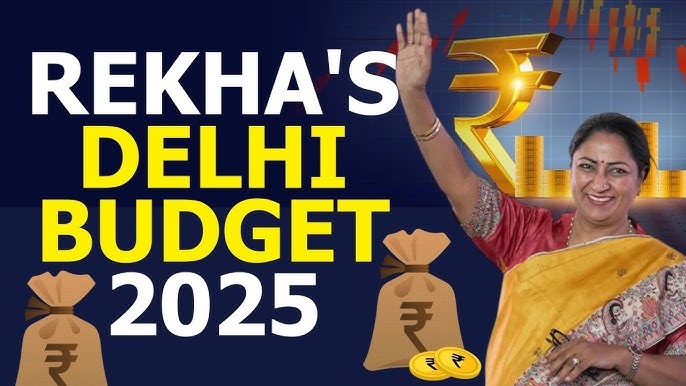On March 25, 2025, Delhi Chief Minister Rekha Gupta, who also holds the Finance portfolio, presented the Delhi Budget for the fiscal year 2025-26 in the Delhi Assembly. With an outlay of ₹1 lakh crore, this budget marks a historic milestone as the first presented by the Bharatiya Janata Party (BJP)-led government in Delhi in over 26 years, following their victory over the Aam Aadmi Party (AAP) in the recent Assembly elections. Termed a “historic budget” by CM Gupta, the Delhi Budget 2025-26 reflects a 31.5% increase over the previous year’s ₹77,000 crore allocation, signaling an ambitious vision to transform the national capital into a “Viksit Delhi” (Developed Delhi). This blog dives deep into the budget’s key highlights, sectoral allocations, underlying priorities, and its potential impact on Delhi’s residents.

Overview of the Delhi Budget 2025-26
The ₹1 lakh crore budget is a significant leap from the ₹76,000 crore outlay of the AAP government in 2024-25, revised to ₹77,000 crore. This increase underscores the BJP’s intent to accelerate development across multiple sectors. The budget is financed through a combination of tax revenue (₹68,700 crore), non-tax revenue (₹750 crore), small savings loans (₹15,000 crore), central road funds (₹1,000 crore), centrally sponsored schemes (₹4,128 crore), and grants-in-aid from the Government of India (₹7,348 crore). Notably, 72% of the budget is allocated to revenue expenditure (e.g., salaries, subsidies), while 28% (₹28,000 crore) is dedicated to capital expenditure—a doubling from the previous year’s ₹15,000 crore—highlighting a strong focus on infrastructure development.
CM Gupta emphasized that this budget is not merely a financial document but a transformative vision to address Delhi’s longstanding challenges, such as poor infrastructure, pollution, and water scarcity, while fulfilling the BJP’s election manifesto promises. The budget revolves around ten key focus areas: infrastructure, electricity, roads, water, connectivity, women’s welfare, education, healthcare, tourism, and environmental sustainability.
Key Highlights and Sectoral Allocations
1. Infrastructure Development: Rs 28,000 Crore
The doubling of capital expenditure to ₹28,000 crore is a cornerstone of the budget, aimed at reversing what CM Gupta described as a decade of “incomplete projects, broken roads, and traffic jams” under the AAP regime. Key allocations include:
- Roads and Bridges: ₹3,843 crore for improving road infrastructure, including smart expressways and congestion-free corridors.
- Public Works Department (PWD): Approximately ₹12,000 crore for repairing roads and flyovers, marking the highest-ever allocation for infrastructure in Delhi’s history.
- Delhi-NCR Connectivity: ₹1,000 crore, in collaboration with the Union Ministry of Road Transport, to enhance connectivity with the National Capital Region (NCR) through new expressways and industrial zones.
This aggressive push for infrastructure reflects the BJP’s intent to modernize Delhi’s urban landscape, though questions remain about execution timelines and the feasibility of such large-scale projects in a densely populated city.
2. Women’s Welfare: Rs 5,100 Crore
A flagship promise from the BJP’s manifesto, the Mahila Samruddhi Scheme, allocates ₹5,100 crore to provide ₹2,500 per month to eligible women. This initiative aims to empower women economically, contrasting with the AAP’s Mukhyamantri Mahila Samman Yojna (₹1,000/month). Additional measures include:
- Free Bus Travel: Replacing AAP’s pink ticket system with a common bus pass for women to curb ticketing corruption.
- Women’s Safety: ₹50 crore for installing 50,000 CCTV cameras across Delhi, addressing a critical concern in the capital.
While these schemes signal a strong gender focus, their success hinges on effective eligibility criteria and transparent implementation—areas where past Delhi governments have faced criticism.
3. Transport Sector: Rs 12,952 Crore
Delhi’s public transport system, already boasting the world’s third-largest e-bus fleet (2,152 electric buses), will see further expansion with:
- E-Buses: 5,000 new electric buses to be added, enhancing eco-friendly mobility.
- Metro Phase IV: ₹2,929 crore to address delays inherited from the previous government, which left a ₹6,000 crore liability.
The digitization of ticketing systems and a unified card for women commuters aim to eliminate corruption and improve efficiency. However, the ambitious scale of this expansion raises logistical and funding challenges, especially given Delhi’s traffic congestion woes.
4. Clean Water and Sanitation: Rs 9,000 Crore
Water supply and sanitation, perennial issues in Delhi, receive a massive boost with:
- Delhi Jal Board: ₹9,000 crore—triple the previous allocation—to ensure clean drinking water and reduce reliance on tankers.
- Sewerage Upgrades: ₹500 crore for repairing and upgrading sewage treatment plants (STPs) and ₹250 crore for replacing old sewer lines.
This allocation responds to public outcry over water shortages and tanker mafias, but the real test lies in ending systemic inefficiencies within the Delhi Jal Board.
5. Yamuna Cleaning: Rs 500 Crore
The polluted Yamuna River, a focal point in Delhi’s elections, gets ₹500 crore to ensure only treated water enters it through the decentralization of 40 STPs. This ambitious environmental goal, while laudable, faces skepticism given the river’s persistent pollution despite decades of investment.
6. Education: Rs 750 Crore + Additional Funds
Education, a priority under both AAP and BJP regimes, sees innovative investments:
- Free Laptops: ₹750 crore to provide laptops to 1,200 students passing Class X, promoting digital learning.
- CM Shri Schools: ₹100 crore for new schools aligned with the National Education Policy (NEP), inspired by PM Shri schools.
- Education Hub in Narela: ₹500 crore to develop a 160-acre education hub.
These initiatives aim to reform Delhi’s government schools, but the absence of a detailed breakdown for total education spending (unlike AAP’s ₹16,396 crore in 2024-25) leaves some gaps in understanding the full scope.
7. Healthcare: Rs 6,874 Crore
The health sector receives ₹6,874 crore, with specific allocations:
- Ayushman Bharat: ₹2,144 crore to provide an additional ₹5 lakh insurance coverage atop the central scheme’s ₹5 lakh.
- Health and Wellness Centers: ₹320 crore for establishing and expanding Ayushman Arogya Mandirs.
- Pregnant Women: ₹210 crore for nutrient kits and a ₹21,000 allowance.
This builds on the BJP’s welfare promises, contrasting with AAP’s Sanjeevani Yojana, though execution will determine its efficacy in a city with strained public health infrastructure.
8. Pollution Control and Environment: Rs 806 Crore
Delhi’s infamous air quality crisis gets attention with:
- Pollution Control: ₹300 crore for initiatives to curb pollution.
- Environment and Forest: ₹506 crore for green cover and sustainability projects.
While these funds signal intent, they may fall short of the scale required to tackle Delhi’s annual smog emergency, a challenge that demands inter-state coordination.
9. Tourism, Art, and Culture: Rs 117 Crore
A novel focus on tourism includes:
- International Film Festival: ₹30 crore to host a global event, boosting Delhi’s cultural profile.
- Tourism Promotion: ₹117 crore for branding and heritage development.
Quoting Mirza Ghalib, CM Gupta underscored Delhi’s cultural significance, aiming to position it as a tourism hub—a promising but untested venture for the capital.
10. Slum Development and Social Welfare: Rs 10,743 Crore
Social welfare sees robust funding:
- Slum Clusters: ₹696 crore for development.
- Atal Canteens: ₹100 crore for 100 canteens to feed the poor.
- Social Security: ₹10,047 crore, including a pension hike from ₹2,500 to ₹3,000 for persons with disabilities and women in distress.
These measures target Delhi’s marginalized communities, contrasting with AAP’s alleged focus on elite projects like the “Sheesh Mahal.”
Critical Analysis: Strengths and Challenges
Strengths
- Bold Vision: The 31.5% increase and doubled capital expenditure reflect a proactive approach to Delhi’s infrastructure deficit.
- Public Participation: Over 10,000 suggestions from citizens, collected via WhatsApp (9999962025) and email, indicate an inclusive process.
- Focus on Welfare: Schemes for women, students, and the underprivileged align with PM Narendra Modi’s “Sabka Saath, Sabka Vikas” ethos.
Challenges
- Execution Risks: Ambitious projects like Yamuna cleaning and 50,000 CCTV cameras require meticulous planning and monitoring, areas where past governments have faltered.
- Transparency Concerns: The absence of an Economic Survey for 2024-25, as criticized by Leader of Opposition Atishi, raises questions about the data backing these allocations.
- Funding Feasibility: With ₹15,000 crore from small savings loans, the budget’s reliance on borrowings could strain Delhi’s fiscal health if revenue targets falter.
Political Context and Implications
Presented amid chants of “Modi, Modi” and jabs at AAP’s “Sheesh Mahal” controversy, the budget doubles as a political statement. CM Gupta’s 138-minute speech framed it as a break from a decade of “corruption and inefficiency,” positioning the BJP as Delhi’s savior after 27 years out of power. The reference to Lord Ram’s return after 14 years of exile further ties the budget to a narrative of redemption and renewal.
For Delhi’s residents, the budget promises tangible improvements—better roads, cleaner water, safer streets—but its success depends on overcoming bureaucratic inertia and political opposition. The AAP, now in opposition, is likely to scrutinize every rupee spent, especially given their legacy of fiscal discipline (e.g., reducing Delhi’s debt-to-GDP ratio from 6.6% in 2015 to 3% in 2025, per X posts).
Conclusion
The Delhi Budget 2025-26 is a bold step toward reimagining the national capital as a modern, equitable, and sustainable metropolis. With ₹1 lakh crore in play, CM Rekha Gupta has laid out a comprehensive roadmap that balances infrastructure, welfare, and environmental goals. However, the real measure of this “historic budget” lies not in its announcements but in its implementation. As Delhi watches closely, the coming year will reveal whether this vision translates into reality—or remains another set of promises in the city’s complex political saga.
